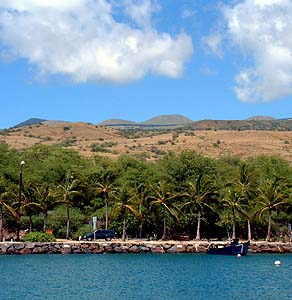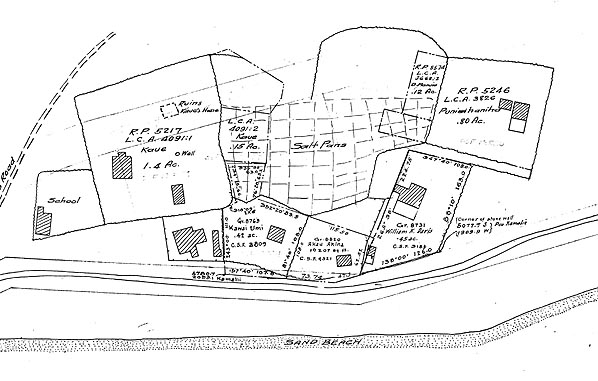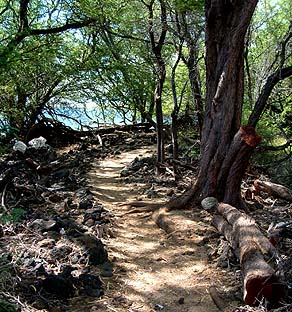 |
 |
 |
|||||
|
|
|||||||
| |
|
|
|
“If you could only have seen,” Pua begins. “I always say this to my two sons, because they really love the ocean. I say, ‘Had you seen where I grew up, you would never want to live where we do now. You would fight to the end to save our property where we came from,’ I said. We didn’t have much, our home was just another old fashioned family Hawaiian living. "When you walked out into our big patio, you looked out to the ocean, the reef was so beautiful. In the morning, the tide would be so low, that you could almost walk out to the reef from where we lived. Just beautiful, beautiful. And all the beach where we come from was miles of beach and the water was crystal clean.”
|
||
|
|
||
“There were about 30 families,” Lani recalls. “And we all grew up like family. There was no mayor or anyone in charge. There was a police officer but he worked in Waimea. And there was my uncle, my mother’s older brother, but he worked in Waimea too. Nobody would get in trouble. We all grew up, everybody was like family. If this one needed help, then you would help them. If that one needed help, then you would help them." “The village, all we do for a living is fishing,” Lala says. “That’s it. Unless you were sheriff or something—and we had one, but nobody fought too much. It was one whole family, living on the beach.”
|
|
|
“We did a lot of fishing,” says Papa Akau, “and fishing boats and equipment were right down here where the pier is, just around that area. That’s where we had them, right on the beach. We had a shed, we had storage, we had nets, boats and net dryers and stuff like that." “In those days, we didn’t have skiffs,” Lala elaborates. “We had canoes. These were wood canoes, but not koa. They were plywood, with outriggers. We landed the canoes on the sand. We had these rollers, put them under the canoes and just roll it up in the sand with a board underneath. Could be two by fours. Put the rollers on so they won’t sink down in the sand. Two guys could just push the canoe right up to the sand, where the high tide wouldn’t get it. “We had bamboos lined up, about 5 feet tall. Then we’d pull our net over them to dry. We made nets ourselves. It’s not easy. It used to take about a year to make a net. But nowadays it takes a day. Because now, all you have to do is join them together.”
|
|
|
|
|
“The only transportation on the ocean was canoes,” Lani says. “Outrigger canoes, without sails. But a lot of fisherman had big boats, too. The boat houses down there on the beach, my Dad owned one too. They built them with cheap material. And they just keep the boats over there. We used to go down there and play. If you had a boyfriend, you’d go there and meet your boyfriend there. "I used to see these two Japanese brothers. One of them would go there every morning. I said, ‘What the heck is he doing there?’ Then one day I crawled underneath and I went in and he was with a young girl there. And he told me, ‘shhh shhh,’ he didn’t want me to tell anybody.”
|
||
|
|
||
“Right across the street used to be our boat builder” Pua remembers. “That’s the Matsumoto family lived there. And upstairs they had the living quarters, downstairs was the dining room and they never had a floor, it was all dirt. And from the upstairs of the house they had a finger pier, where the father, when he would get a boat done, he would take it out to this finger pier and then people would get on the boat and try it out. "A finger pier is like part of your home. They use that like a walkway, to go out to the tip where the boat is going to go. So it is a pier. But it’s like attached to your house, and they call it the finger pier. "And during our days, we didn’t have trailers, they had rollers. They put the boat on them and they had tracks. And everybody had to help push it to get the boat going.”
|
|
|
“There was a pond there when I was there, in the ‘30s," Mel states. "I think that pond over there was from King Kamehameha’s days. The kapu for that pond was that, if you don’t have anything food on your table, you could get what you need. And then no more get for sell. It’s for you, you live around here, that’s for us. "I don’t know if that kapu was from my Grandfather them, but it was a known fact that the families poor to eat would net. Throw net. Maybe one or two times you throw, you get enough for your table already. Fish are about fourteen inches."
|
“The fish pond, my grandfather was a caretaker of this,” Papa says. “Was kind of deep and lot of growth of limu and stuff like that. So, my grandfather, what he did was to get the small awa along the shore line and put it in, get three fish ponds, small ones. He used to put the young ones in it, grew up and then move in next pond until come over here, in a bigger pond. Awa, mullet, there’s those two. "And then when Parker Ranch had the party, what they do, they take the big awa down at Anaeho‘omalu. There’s a big fish pond down there. They take the fish for the party and after that, then they take the young ones from here, replace it, you know. So that’s why this pond was important to Parker Ranch. But that’s gone."
|
|
| |
|
|
“My grandfather used to do make his own salt,” Lani remarks. “All I know is that they used to get water, salt water, really good salt water and I wondered why was all this water here. One day I said, I said, I asked, my mother said, ‘That’s where your grandfather makes Hawaiian salt.’ The salt pans, you let it dry and then that’s where they get their salt from.” Mel says, “Let’s see, from my grandfather’s house had the Davis family, 200 yards was the salt flats (in the direction of Kona) when it came high tide, the water fills up the place, that’s a natural salt pan, everybody used to go there to get salt…the regular white salt." "The saltpans at Kawaihae had individual names," Marion writes. "There were one of each with the following names: Pohakuloa, Pipipi, Nuapae, Makela, Pu‘uopaa, Poemaka, Kaniku, Kapahukapu, Wiliwili, Kukui; and two each named Kaulanaio and Maluhuehue. The generic name was poho pa‘akai ("depresssions where salt is gathered")" (Kelly 1974: 34).
|
||
|
|
||
“The Kings Trail is still there,” Mel points out. “On the Pelekane trail, you can go to Kohala. The King’s runners would go from point to point. And they used them for the Makahiki. "For the Makahiki, you go clockwise. It’s a clear trail. The trail is good down by the hotel, because they had to keep the trail in place, so they take care of it. It’s there. You go a certain place you can see that thing go down for miles. "But you know, just running on that a‘a, I don’t know. They had shoes like slippers before, or they had feet like leather! They’d run on, and the fish was still alive when they got them there.”
|
|
|
“Going up past the bridge, a trail goes up on the mountain,” Papa explains. “That’s supposed to be a trail that leads from Honokoa all the way up to Pu‘uhue, way above North Kohola. "And then there is what they call Ala loa, a straight road, and from every other ahupua‘a that runs down, then you have a mauka-makai trail that goes and hits this. You see, every other ahupua‘a is supposed to have one. From Honokoa Gulch it goes straight up to Pu‘uhue, and then from mauka-makai goes hit the trail like that, every other one.
|
| |
|
| Gathering along the shoreline was an important part of seaside life in Kawaihae.
|
||
|
|
||
|
|
|
|
|
|

|
| Kawaihae Home | Map Library | Site Map | Hawaiian Islands Home | Pacific Worlds Home |
|
|
|
|
|
|
|||
| Copyright 2006 Pacific Worlds & Associates • Usage Policy • Webmaster |
|||














